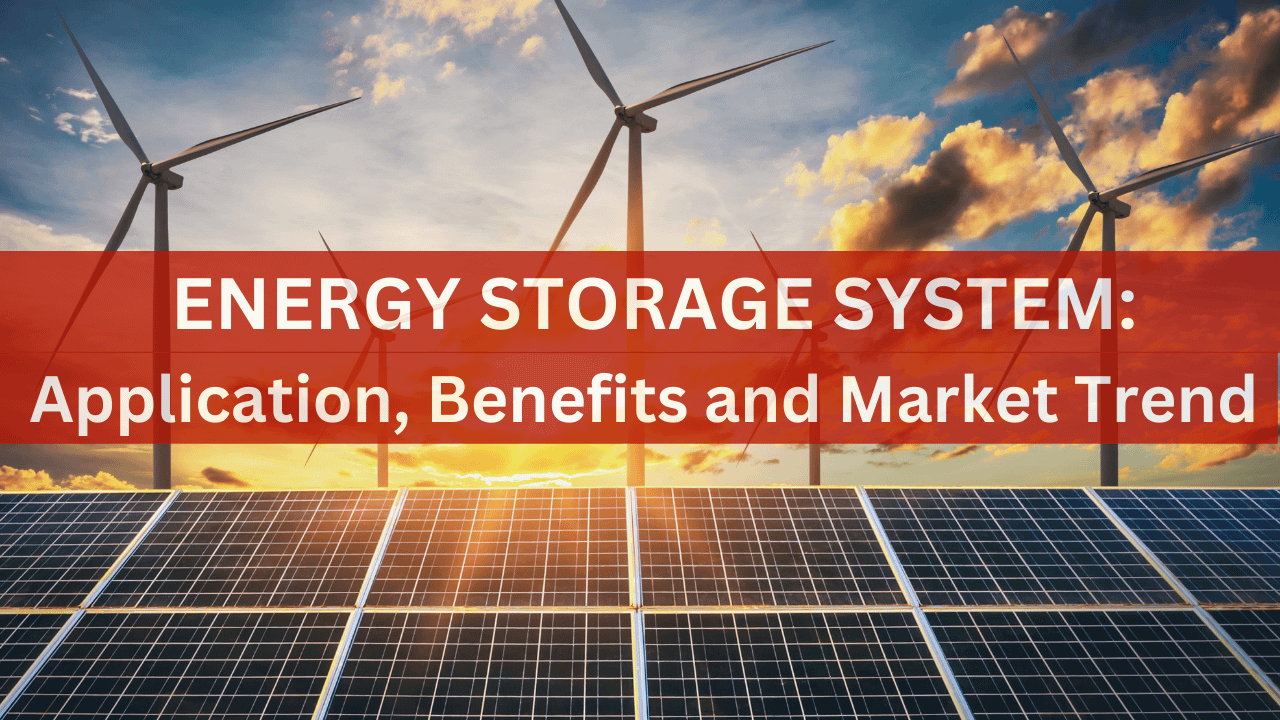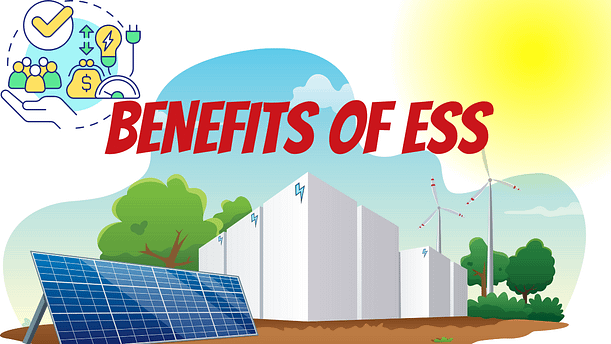Energy Storage Systems: Applications, Benefits, and Market Trend
Energy storage systems (ESS) play a pivotal role in the modern energy landscape by addressing the intermittency and variability of renewable energy sources. As the demand for cleaner and more sustainable energy solutions grows, ESS technologies have gained significant attention.
Energy storage systems (ESS) have emerged as a key innovation in the energy sector, enabling the integration of renewable energy sources, promoting grid decentralization, and catering to the growing demand for portable electronic devices and electric mobility. In 2023, energy storage systems are a trending topic in energy innovation, driving advancements in various technologies and applications.
Applications Of Energy Storage System
Energy storage technologies come in diverse forms, each suited for different applications and availability. Examples include batteries, pumped hydro storage, flywheels, compressed air energy storage, thermal energy storage, and hydrogen storage. These technologies play a vital role in shaping a sustainable energy future.
The importance of energy storage systems lies in their ability to address the intermittency of renewable energy sources, manage peak demand, enhance grid stability and reliability, and facilitate the integration of small-scale renewable energy systems.
Intermittency of renewable energy sources
Renewable energy sources, such as solar and wind, are dependent on natural resources and are thus intermittent in nature. Energy storage systems allow for excess energy to be captured during peak production hours and stored for later use, mitigating the variability of renewable sources and ensuring a consistent energy supply.
Managing peak demand
Energy storage systems help manage peak demand by storing excess energy during periods of low demand and releasing it during peak hours. This reduces strain on the grid, minimizes the need for additional generating capacity, and helps avoid power shortages and disruptions.
Grid stability and reliability
Energy storage systems enhance grid stability and reliability by providing backup power during outages, regulating frequency and voltage, and balancing the supply and demand of electricity. This improves the overall performance and resilience of the electrical grid.
Decentralization of energy generation
Energy storage systems facilitate the decentralization of energy generation by enabling small-scale renewable energy systems, like rooftop solar panels, to store excess energy and feed it back into the grid when needed. This promotes energy independence, reduces transmission losses, and supports the development of smart grids.
The development and widespread adoption of energy storage systems are vital for achieving a sustainable energy future. These systems contribute to reducing greenhouse gas emissions, improving energy access and security, and optimizing the utilization of renewable energy sources. As the energy sector continues to evolve, innovations in energy storage systems will play a crucial role in shaping a cleaner, more reliable, and decentralized energy landscape.
Benefits Of Energy Storage for Homes and Businesses
Renewable Energy Sources, Such as Solar Power, Wind Power, And Tidal Power, Offer a sustainable and replenishing alternative to traditional energy generation methods. These sources rely on abundant resources that do not deplete over time, contributing to a greener and more sustainable future.
Among these renewable energy sources, solar power and wind power are widely utilized. However, they face a common challenge—they are not available constantly. Solar power is generated during daylight hours, while wind power relies on the availability of wind. This intermittency poses a significant hurdle as energy demand does not align perfectly with the availability of these resources. Consequently, effective energy storage becomes crucial to bridge this gap and ensure a reliable power supply.
Battery storage plays a vital role in addressing the intermittent nature of renewable energy sources. It enables the capture and storage of excess energy generated during periods of high production, such as sunny or windy days. This stored energy can then be utilized during periods of high demand or when renewable sources are not actively generating power, such as at night or during lulls in wind activity.
RESILIENCY
Energy storage provides emergency backup power, ensuring electricity supply even during adverse conditions or grid outages. By combining energy storage with solar panel systems, users can keep their lights on and essential appliances running, enhancing resiliency in homes and businesses.
FINANCIAL BENEFITS
Energy storage systems can offer financial advantages in certain scenarios. For instance, if you are on a time-of-use rate or have demand charges, you can draw power from the battery during peak hours, avoiding higher electricity rates from the grid. Additionally, energy storage can optimize savings from solar installations by enabling greater on-site consumption of self-generated solar power, particularly in cases where one-to-one net metering is not available.
INTEGRATION OF RENEWABLES
Energy storage plays a crucial role in better integrating renewable energy into the grid. As renewable sources, such as solar and wind, have variable power production, energy storage allows for the storage and dispatch of renewable energy when demand is high. By making renewable energy dispatchable, energy storage helps align renewable power generation with electricity demand, reducing reliance on fossil fuel-fired power plants and minimizing emissions.
Enhanced Energy Utilization
Battery storage allows for better use of renewable energy by storing excess power generated during periods of high production. This stored energy can be utilized during periods of low production or high demand, ensuring a consistent and reliable power supply. With batteries, you can tap into your stored energy when your solar system doesn’t produce enough power, reducing your reliance on the grid.
Grid Independence
Solar battery systems reduce dependence on the grid, making homes and businesses more self-sufficient. In rural areas or locations with unreliable grid infrastructure, battery storage allows for a higher degree of energy independence. By storing excess solar energy, you can power essential appliances and critical loads during grid outages or high-demand periods, reducing your reliance on external power sources.
Environmental Benefits
Utilizing battery storage with renewable energy sources helps reduce your carbon footprint. Solar energy systems generate clean electricity with minimal pollution compared to fossil fuel-based power sources. By maximizing the use of solar energy through battery storage, you can minimize waste and further reduce greenhouse gas emissions, contributing to a greener and more sustainable environment.
Market Trend and Research
The global energy storage systems market has witnessed significant growth due to advancements in technology, ensuring a continuous and reliable energy supply. With the increasing adoption of renewable energy sources, the demand for storage systems for renewable energy has surged worldwide. This demand is driven by the rising need for energy consumption across the globe and the shift towards cleaner and more efficient energy sources.
In 2021, the energy storage systems market reached a valuation of US$ 210.92 billion. Over the next decade, it is projected to soar to US$ 435.32 billion by 2030, with a steady compound annual growth rate (CAGR) of 8.4% from 2022 to 2030. The dominant technology segment in 2022 was pumped hydro, capturing a substantial 95.4% share of the overall market.
Government and private investments in renewable energy production have played a vital role in driving the growth of the global energy storage systems market. The focus on renewable energy production has led to a higher demand for storage systems to efficiently manage and utilize the generated energy. Additionally, the growing demand for batteries, driven by various industries and applications, has contributed to the expansion of the market.
AFFORDABILITY:
Battery storage prices continue to decline at a rate exceeding industry prediction. The expanding electric vehicle (EV) market has played a significant role in driving down costs, benefiting the power generation sector. Projections indicate further cost reductions of 28%–58% by 2030 and 28%–75% by 2050.
FLEXIBILITY:
BESS offers high flexibility and can be rapidly deployed. It functions as both a generator and a load, providing stability to the grid, backup or supplemental electricity, and other benefits. Its flexibility makes it a natural complement to renewable energy assets like solar and wind, contributing to grid stability.
EVOLVING BATTERY TECHNOLOGY:
Lithium-ion batteries are the primary technology used in BESS and EVs. The low cost and increased demand for EVs have led to supply imbalances. However, ongoing research and development efforts are exploring alternative battery chemistries such as sodium-ion batteries, flow batteries, and iron-air batteries, which are gradually approaching commercial production.
SECOND-LIFE BATTERIES:
EV batteries degrade significantly in the first five years of use, no longer meeting the stringent requirements of EVs. However, these batteries still have remaining useful life and can be repurposed for stationary energy storage applications. By 2025, second-life batteries are expected to be 30%–70% cheaper than new batteries for similar applications, making them a cost-effective option.
VIRTUAL POWER PLANTS:
Virtual power plants are emerging as an exciting trend in grid modernization. They involve aggregating multiple BESS units installed at distributed locations, such as residential or smaller complexes. By consolidating the stored energy from various distributed resources, virtual power plants enhance grid resilience and provide stable and reliable power. This approach reduces reliance on new transmission infrastructure investment and improves the grid’s ability to withstand severe weather events.
These trends collectively contribute to the growth and adoption of BESS, making it a crucial component of the evolving energy landscape. Affordability, flexibility, evolving battery technology, second-life batteries, and virtual power plants all play a vital role in driving the development and implementation of energy storage systems.
In conclusion, the energy storage systems market is expected to experience significant growth due to factors such as rapid industrialization, concerns regarding air pollution and carbon emissions, increasing demand for uninterrupted power supply, research and development investments in renewable energy infrastructure, and government initiatives supporting clean energy adoption. With these drivers in place, the energy storage systems market is projected to witness substantial expansion in the forecast period.









